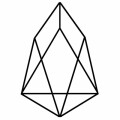

EOS (EOS) Price and Reviews
EOS Overview
EOS is the 12th largest coin in terms of capitalization in the Coinmarketcap ranking. Its creator took in the development of the Steemit blog, which for several years has been paying a fee for publishing articles with the STEEM token.
The EOS blockchain network after its launch immediately caused a stir in the digital asset market. Some analysts predict its great future, putting ahead of the patriarch of cryptocurrencies Bitcoin.
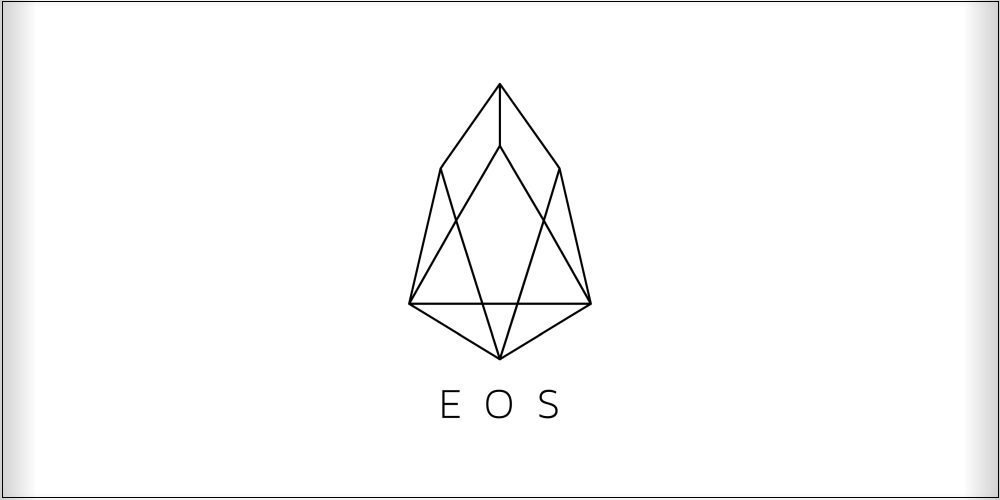
In May 2017, Dan Larimer announced the release of the EOS project at the Consensus Conference. At the time of the announcement, the creator already had two successful cryptocurrency platforms behind him: the BitShares exchange, opened in 2014, and the Steemit social network, which has been functioning since 2016 and has its own cryptocurrency, designed to reward user activity. Both developed projects have an impressive speed of transactions within the system and a good reputation, which positively affects the reputation of the new project.
According to Dan himself, both previous projects helped him gain knowledge and will decide to implement a more complex project on the blockchain, namely the creation of software with which developers can quickly launch complex decentralized projects, applications, social networks, and exchanges.
EOS is the property of Block.one. The development team consists of 50 people. Block.one is registered in the Cayman Islands, with U.S. headquarters in Arlington, Virginia, and offices in Hong Kong and Los Angeles.
The goal of the creators is to make EOS the fastest, scalable, and easiest to use blockchain in the world. The basis for the success of EOS was the launch of a platform for application development. The development of new tools and libraries for programmers creating blockchain applications based on EOS is the area of constant attention of the development team.
The initial offer of EOS tokens lasted for a whole year, from June 2017 to June 2018. Thanks to a good marketing campaign, the new cryptocurrency caused a stir among investors, which was immediately used by dishonest dealers who started selling fake coins. And this to some extent affected the reputation of Block.one, which has not even managed to release a full-fledged version of the EOSIO toolkit.
During the ICO, 1,000,000,000 tokens were issued, 10% were reserved by developers, the rest were brought up by investors. It was originally planned that the EOS cryptocurrency will go to auction after the completion of the ICO campaign, but after two months the coins were freely sold on cryptocurrency exchanges. Block.one raised a record of $ 4 billion during the ICO, leaving many other successful projects far behind. Many experts and ordinary users even began to doubt the feasibility of such huge funding, and the project team is forced to make every effort to dispel these doubts.
EOS Advantages
EOS is a platform for developing decentralized applications, the main competitor of Ethereum. It has a simple and convenient interface, and a very high (up to 100,000) transaction processing speed. Internal coin of the EOS Token ERC-20 blockchain network, created on the basis of Ethereum. The main advantages of the EOS platform are:
- High scalability. The system supports functions such as asynchronous communication and parallel execution. Thousands of commercial applications work in it and transactions are carried out almost instantly.
- Convenience for developers. An extensive set of tools and a web-assembly platform are available. Here you can stop and adjust a failed application, use ready-made templates for creating interfaces and client databases.
- Free access to basic functions. If you wish to launch a blockchain ecosystem or a decentralized application on the EOS platform, components for creating are available for free.
The company promises to invest the lion's share of the amount received from the sale of tokens in the further development of its project, which guarantees the maintenance and increase in the capitalization of internal cryptocurrency.
The main competitor of EOS is the Ethereum platform. To compare profitability, it’s worthwhile to clarify that the competitor’s transaction speed is only 20 operations per second, and a fee of $ 0.075 is charged from users for each operation.
EOS is quite attractive to investors. It has developed an innovative system of attracting third-party capital: the potential capabilities of the system are distributed among all network users in accordance with the number of available EOS coins. So if the user has n% tokens, then he automatically has the right to dispose of the corresponding n-th percentage of the resource, thereby opening up a huge number of opportunities for earnings. Coin holders are also provided with such bonuses:
- Owners can charge for transactions within the system;
- Providing access to storage in the blockchain;
- Impact on system management;
- Access to applications developed in the system and their users;
- Dividends from EOS;
- Airdrops - distribution of cryptocurrencies existing within the system.
EOS Price Prediction 2021-2025
Representing an improved copy of Ethereum, cryptocurrency forecasts for the future are rather contradictory. Some experts, confident in the success of the project, called the EOS platform “Ethereum killer” and believed that in the future it would compete with Bitcoin. Such a forecast was based on the following facts.
- EOS is a cryptocurrency that has entered the market relatively recently, but in terms of capitalization, it is already quite comparable with the top blockchain projects.
- The EOS network has a very loyal fee policy.
- A large number of tokens issued during the period of the record-high ICO reduced the volatility indicator.
- The EOS team tried to take into account the mistakes of its competitors and, when creating the ecosystem, gave maximum attention to protection from hacker attacks and bugs in the work.
At the start of sales of EOS tokens, their price was equal to $1 per unit. At the beginning of 2018, the token exchange rate was up to $14.59, and the total capitalization of the currency took the leading position in the rating. However, soon the price has dropped to $2.5. Ever since it was struggling to reach the $5 mark.
Observing the ever-growing interest in the EOS cryptocurrency project, supporters of an optimistic scenario of the likely development of events believed that in 2021 the price of EOS will reach $3.3.
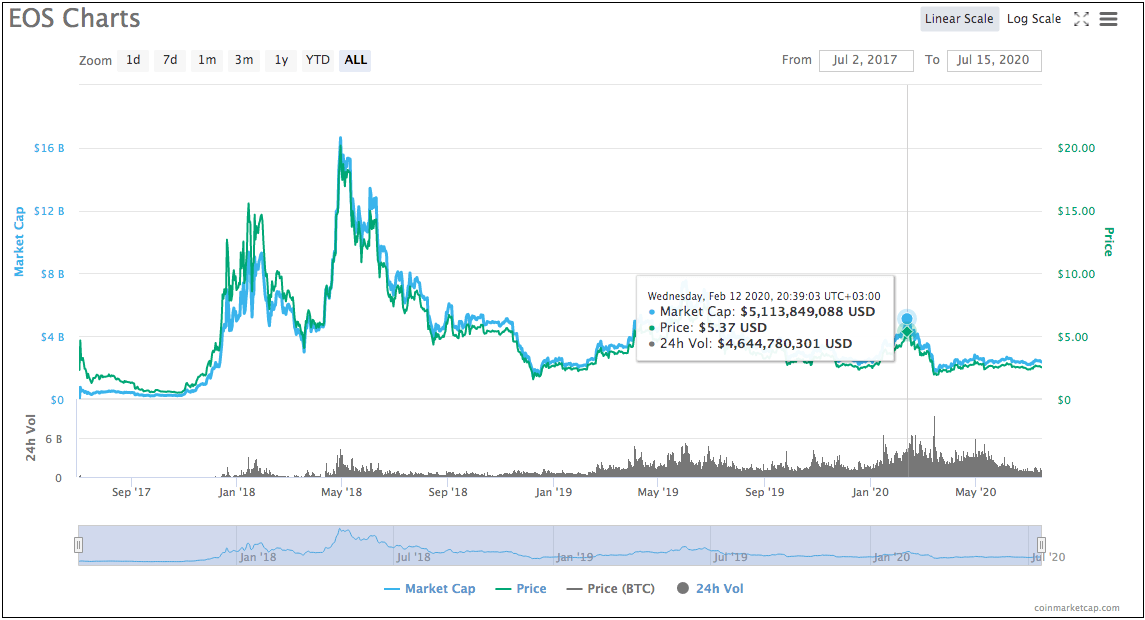
The project successfully survived in the crypto-winter and retained its position in the top 10 crypto-networks with the highest capitalization rating, ahead of Monero, Zcash, and Dogecoin.
Many experts predict that according to the previous trend, EOS has every chance of reaching a price of $5-7 by the end of 2021. However, we see this forecast as optimistic. It's more likely that such a value could be possible by the end of 2023. And in 2025, according to positive estimates by experts, the price for an EOS coin can be $ 25-30. Our prediction is $12 at best.
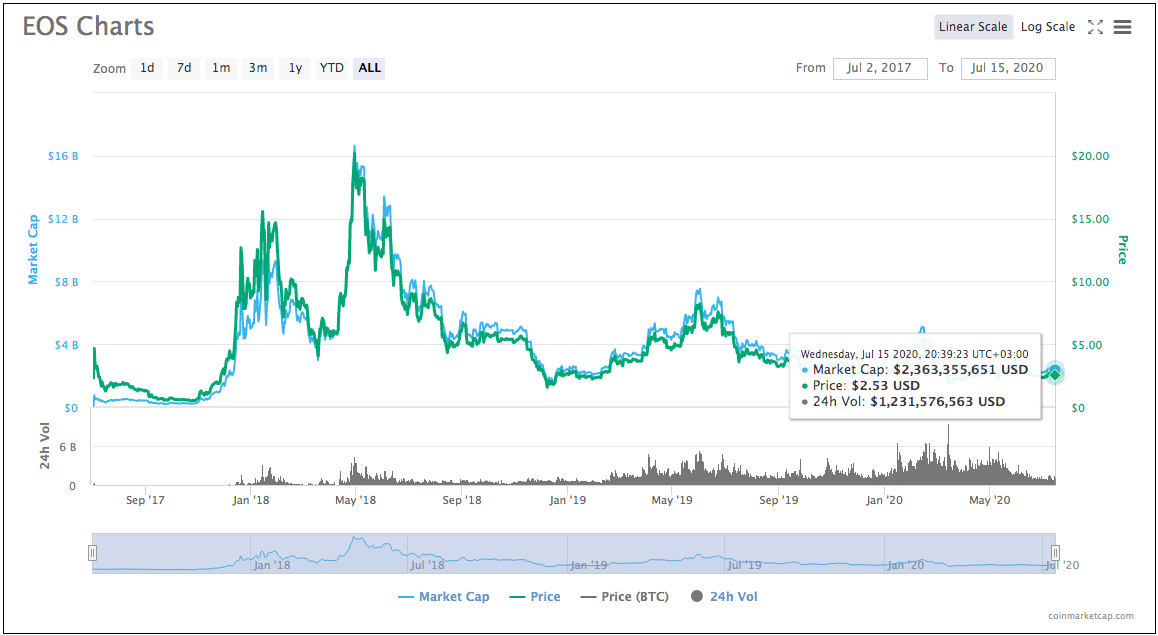
However, one can never predict market movements, especially when it comes to the cryptocurrency market. At the time of writing, the EOS token is selling for $2.82. But pessimists who believed that cryptocurrency, most likely, did not enter the top of the most popular and sought-after coins, were also wrong.
The future fate of the ecosystem depends on the developers and holders of tokens. The problem is that the coin is not a decentralized system. Half of the coin’s turnover is controlled by a small group of users, this gives them the ability to quite easily influence the value of digital assets. The EOS token is quite stable, although it depends on the bitcoin exchange rate, the threat of a 51% attack on this network is much more real than that of Ethereum or another well-known crypto network.
How to Get EOS?
One of the simplest and most common options for acquiring EOS cryptocurrency is to buy currency on the exchange.
Before purchasing, you should prepare a place for storing cryptocurrency and its further use, if you do not want tokens to be stored on the exchange wallet.
An official EOS cryptocurrency wallet has not been developed. The company has developed only a command-line wallet, which can be obtained together with the EOSIO software, but there is no graphical interface to it, but there are third-party resources that developed it. However, Block.one did not support any of the projects and offers users to independently explore the market and choose an individually suitable method. The company also does not plan to release a hardware wallet.
Bitfinex and Bittrex are the first cryptocurrency exchanges to support the project and add EOS to their system. They account for about 60% of the total turnover of this cryptocurrency. Bitfinex is also different in that it added an EOS-USD trading pair.
EOS Mining
In the EOS ecosystem, mining is absolutely impossible. Here, unlike Ethereum, which still supports the Proof-of-Work (PoW) consensus algorithm, the Delegated Proof of Stake (DPoS) protocol was originally introduced. Its essence is that all network participants select a small group of users (21 validators) that create blocks. After 24 hours, powers are transferred to the next group of producers, and so on.
At the same time, production does not occur as such; validators receive a reward for processing transactions. DPoS is a modification of Proof-of-Stake, in which the proof of the share was replaced by voting, the block reward was removed, leaving the commission fees to the nodes. The system seems very democratic, but any electoral process can be manipulated if desired.
Conclusion
Under the buzz of criticism, the project nevertheless raised an impressive amount of investment, and the cost of cryptocurrency continues to grow. In April 2018, the company itself surpassed SpaceX by $ 17 billion in capitalization, which indirectly proves investor confidence in the project, as one company launches ships into space, and the second only released a beta version of the crypto project.
A huge advantage and at the same time a drawback is that EOS is an internal cryptocurrency of the system, the growth of which is fully associated with the intensity of the development of the platform. However, even the creators do not make predictions about how fast it will develop.
In addition, the company already has competitors having a common development line with it: Ethereum, Tezos, Aeternity, Quantum, and Tauchain. The continued popularity of EOS also depends on their pace of advancement.
The very idea of the project is innovative. If it is implemented in accordance with the stated promises, the project can become a completely new round in the development of the blockchain and bring prospects to the company investors and token holders in the form of an impressive income. But is it worth betting on a project that is just starting to be implemented, while not providing guarantees? Everyone must decide for himself.
While the project is only gaining momentum and the purchase of tokens can make a profit even on the difference in rate, but you need to be prepared for the fact that at any moment the price for cryptocurrency can begin to decline, which can lead to the shutdown of the project itself.
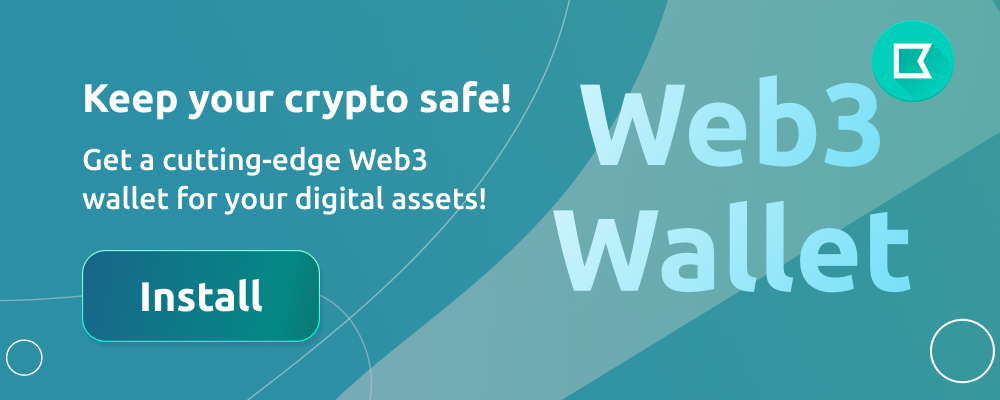
EOS is easily one of the best chains in the ecosystem. It ticks a lot of boxes for ease of use; and scale-ability. I would never build a complex system, game, or token on ETH because of the end user's cost. While on EOS it's much cheaper and easier to develop a smart contract and launch an entire project in hours. On top of that; we don't have to worry about things such as developer errors or catastrophic bugs which would force you to launch another contract on ETH. If you're looking for the future; it's with EOS. Professional, fast, and one of the best communities to follow on Telegram.
EOS has shown the technical superiority in many ways. Latest release of EOS 2.0 shows the speed of development. Back of this, $1bn has been invested in projects that is going to utilize EOSio. Soon EOS will launch the first dapp with the millions of users. I guess is that's going to be #VOICE
EOS is trying to surpass ETH and it has chances to do that. There are an innovative system and relatively high liquidity. But the dev team has to develop the project more in order to catch up ETH. At that moment, there are still some bugs and failure need to be corrected.
EOS is on the largest blockchain. It provides great liquidity and market cap. The support of it gives a good assistance and opportunity to ask some questions about the blockchain. I definitely like it.




